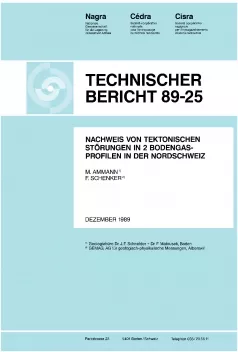
Technischer Bericht NTB 89-25
Nachweis von tektonischen Störungen in 2 Bodengasprofilen in der Nordschweiz
In the Tabular Jura east of Basel, a field campaign using two soil gas profiles each 1.3 km long was carried out to investigate the possibility of geochemical identification of disturbed zones using gases in the soil. The aim was to clarify to what extent multi-component gas analyses along measurement profiles could be used for rapid identification of disturbed zones in the field. The exercise was also intended to provide relevant experience in approaching similar problems and to allow optimisation of test procedures.
By way of introduction, the report gives information on the origin and place of production of the most important soil gases and then goes on to explain the principle of the field experiment and the measurement techniques and equipment used. The results are then presented, together with a discussion and a cross-comparison with the literature data.
The soil gas profiles are at right angles to the Rheinfelden fault (Rheinfelden soil gas profile) and to the Zeiningen disturbed zone (Zeiningen soil gas profile); both these features have a regional character and a dip slip of several hundred metres. There are no geomorphological indications at the earth's surface of recent movements associated with these two disturbed zones, although there is probably neotectonic activity in the Rheinfelden-Zeinigen area.
The gas samples were taken using a push-in probe. Samples were initially taken for both profiles at fixed points 100 m apart (= low-density gas profiles). In a further stage, the gas anomalies determined could be narrowed down by sampling at points in between, resulting in high-density gas profiles.
The gas investigations involved determining concentrations of the following components: hydrocarbons from C1 (methane) to C5 (pentane), CO2, He, H2, N2 and O2. The measurements were made using two gas chromatographs in a simple field laboratory. The H2S content of the air in the soil was also determined using a rapid method (Drägerröhrchen); the external temperature and the temperature at a depth of around 1.2 m were also measured. The radon (Rn) content was also determined along the two profiles using α-cups consisting of plastic films which register the α-radiation over a period of several weeks. Information on the origin of the hydrocarbons and the CO2 was obtained by taking samples for isotope analysis from one measurement location in the vicinity of the Rheinfelden fault.
The investigations show that the most important known disturbed zones can be charted well using the selected procedure. In addition to this, the presumed existence of some disturbed zones could be confirmed and others were discovered for the first time. The gases CH4, C2 to C5, H2 and the gas ratios CO2/O2 and N2/O2 proved to be particularly important for identifying disturbed zones. The concentrations of the gases He and H2S, which are presumably also important from a diagnostic point of view, were unfortunately always below the detection limits (10 and 1 ppm respectively).
If a complete detailed inventory of disturbed zones in an area is to be drawn up and information on the lateral extent of the structures is to be obtained, it would be necessary to have a network of several gas profiles, but the procedure described in this report would seem to be somewhat costly for this type of application. However, it could be continually adapted during extensive reconnaissance exercises to take account of new information, thus minimising the cost involved. Although the best results are to be expected with a combination of as many different gases as possible, preliminary tests in an area carried out under certain conditions (lithological homogeneity, similar types of disturbance, etc.) could reduce the number of measured parameters.
